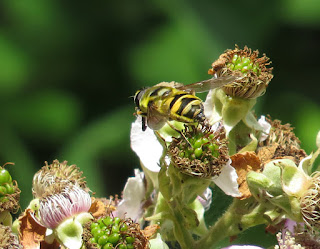This is certainly turning out to be one of my favourite walks at the back of the Cottage. As before it was down to Church Ope Cove and back up to Pennsylvania Castle via St Andrew's Church.
Being the weekend it wasn't a surprise to see so many people out and about, with lots of photographers at the back of Bumpers Lane Quarry photographing the 20+ Chalkhill Blues. Today there were several pairs mating, making it fairly easy to photograph them.
Other butterflies about in the blustery wind were Marbled Whites, Meadow Browns, Ringlets, Gatekeepers, Red Admirals and a Large Skipper. There were also one or two Six-spot Burnet moths.
Yet again another Ichneumon wasp, which stopped briefly, hence the poor shot of it.
On the bird front a Peregrine Falcon buzzed me twice on my way down to St Andrew's Church and like the Ichneumon wasp I managed just a quick shot of it.
A little more obliging was a small Common Lizard on the wall overlooking the bay and in the grounds of St Andrew's Church there were at least 4 Hornet Mimic Hoverflies (Volucella zonaria), a Pellucid Hoverfly (Volucella pellucens) and a Dead Head Fly (Myathropa florea) hoverfly.
Here are a few images from this afternoon:
A Peregrine Falcon (bottom left) makes its way up to the holiday homes above Church Ope Cove.
A Common Lizard. And as the name suggests they are common here.
A pair of Chalkhill Blues mating.
A Marbled White which like many butterflies today was trying to keep out of the wind.
A Ringlet wings closed...........
.......and wings open.
Just the one Large Skipper seen today.
A Mimic Hornet Hoverfly..........
..........and another. In fact at least 4 in the grounds of St Andrews Church.
Today I managed to photograph a Pellucid Hoverfly which eluded the camera the other day.
A Dead Head Fly (Myathropa florea) hoverfly
Wakekam
A wet start to the day here in Wakeham, hopefully it will brighten up later and with it some local sightings.
In the meantime some real news of national importance, my sister Hazel has one of the UK's most endangered birds visiting her back garden in Essex, in the shape of Turtle Dove. There numbers have really dwindled in the past 10 years or so. So to have one visiting your garden is very special.
There is even a website dedicated to this beautiful dove called Operation Turtle Dove and can be found here.
A Turtle Dove visiting my sister's back garden in Essex.











